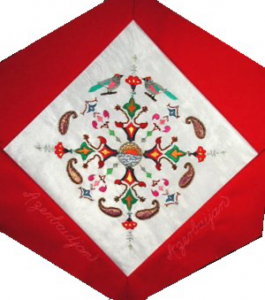Azerbaijan

The Block
This block, created by Neliya Huseynova, is a wonderful example of typical needlework from Azerbaijan, a country famous for its embroidered textiles. Colourful threads, tightly stitched onto a satin background, are used to create a dazzling variety of geometric patterns frequently featured in Azeri designs. Birds, another common motif, are perched in the upper point of the block, representing the country’s wide variety of avian life. In the centre, the sun rises over the sea, a symbol of the nation and of a new day beginning. Beading and pearling, incorporated throughout the piece, are ancient techniques often used to decorate clothes and household articles, and each plays a prominent role in Azeri embroidery.
Cultural Profile
Azerbaijan is believed by some scholars and scientists to be one of the cradles of civilization. Some rock carvings found in the country date back to 10,000 BC. Its capital, Baku, is considered the birthplace of the modern oil industry, and attracted investors and oil developers from around the world. Among them was Alfred Nobel who used the fortune he acquired from his work in this area to establish the renowned Nobel Prize. Azerbaijan is called the ‘land of flames’ as natural gas seeping from the ground and burning is not uncommon in the country. This phenomenon can be seen in the dramatic settings of the Baku Ateshgah, the Fire Temple in suburban Baku, where natural gas has burnt for centuries. Farming is also a large sector of the economy, and more than half of the country is agricultural land.
An ethnically diverse country, Azerbaijan is comprised of more than 70 different groups. Kinship ties have remained strong and the extended family plays an important role in all aspects of Azerbaijani life. Although Russian and Armenian are spoken by some, the principal language is azeri (Azerbaijani) which is closely related to Turkish.
Azerbaijani culture gets its inspiration from both traditional Islamic and European influences. Popular forms of entertainment are folk dances and performances by folk song ensembles. Musical traditions have been preserved by ashugs (poet-singers) who sing about ancient heroes while playing a saz or a gopuz (stringed instruments similar to the lute,) and through mughams, vocal and instrumental songs based on classical poetry. These are accompanied by the tar, a stringed instrument specific to Azerbaijan. Both the ashug and the mugham genres can be performed by men or women.
Azerbaijani arts use Persian and Islamic styles and techniques, and display exquisite craftsmanship, design and ornamentation. Some of the hand-crafts for which the country is well known include pottery, ceramics, metal-work, silk and cotton weaving, and the famous, ancient art of Azeri carpet-making. These rugs display geometric shapes specific to each family, and the designs are usually passed from one generation of weavers to another. Weaving is usually done by women, who sit in pairs and knot strands of wool to the warp cords on the loom. Even though the weavers can work at astonishing speeds, a rug can take up to 3 months to complete. The start of a new rug is usually an occasion for a celebration in Azeri households, but its completion is an occasion for an even bigger celebration! Embroidery also plays a major part in Azeri textile arts, and women’s clothing and various household items are embellished with embroidery featuring the chain stitch, damask stitch, as well as pearls and beads. The complex geometric patterns found in Azeri embroidery and rugs can also be found in shebeke stained glass windows. The complex wooden frames of the windows are assembled without glue or nails, a testament to Azeri craftsmanship.
People have been coming to Canada from Azerbaijan since 1993; before that, they were included in the immigration records with Russians. The Azeri community in Canada is small and is only beginning to emerge. Their numbers were estimated at 4,500 as to the 2011 census.
Sponsor: St. Andrew’s and St. Mark’s UCW, Long Sault, in memoriam Katherine Klassen
